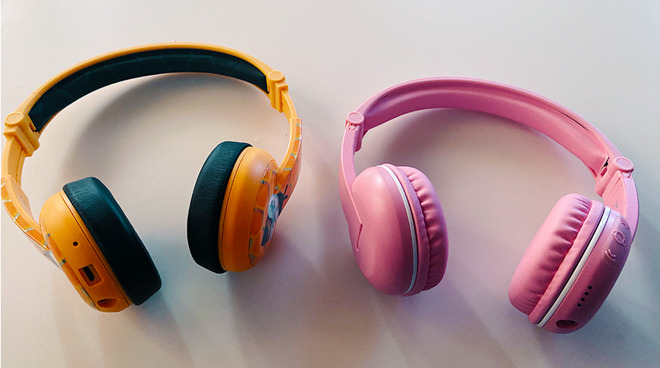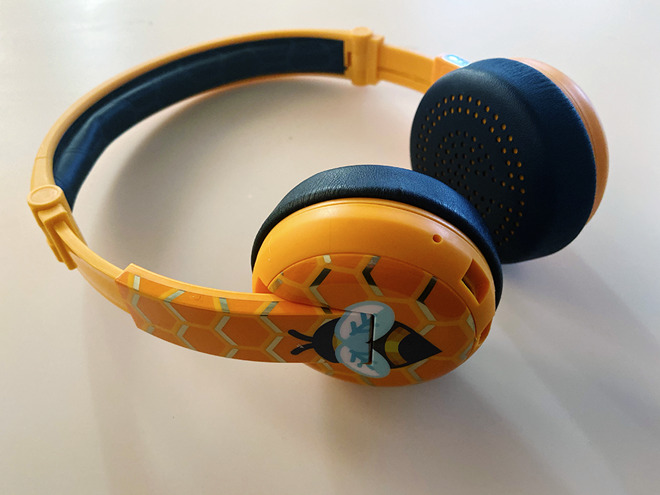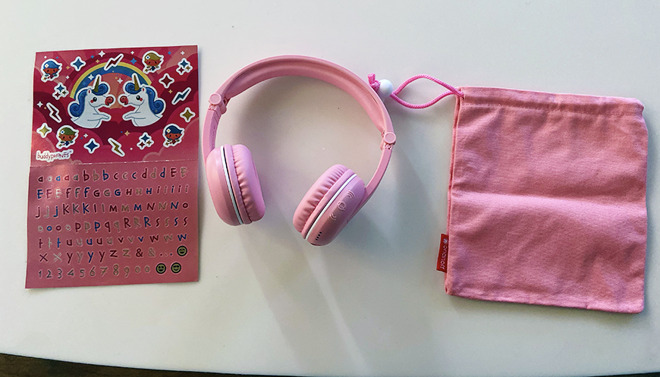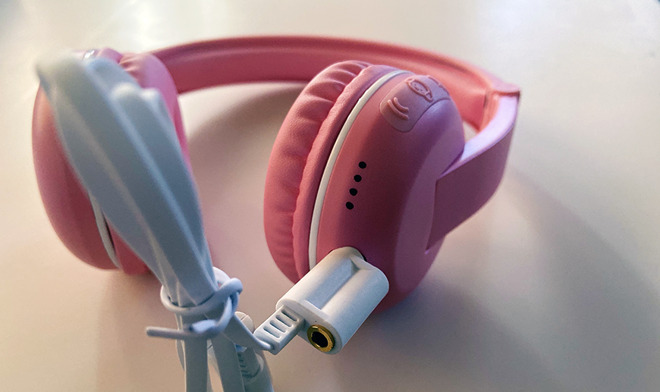Review: BuddyPhones help protect your kids' hearing with built-in volume limiting
If you've got a kid who loves listening to music, playing games, or watching videos, you've probably thought about getting them their own headphones. However, unsafe listening levels are no joke! That's why we're taking a look at BuddyPhones, kid-friendly, noise-limiting headphones designed to keep kids' ears safe.

Noise-induced hearing loss, or NIHL, is a growing concern for parents. Children with hearing loss may potentially face delayed speech, poor communication skills, learning problems, and social isolation.
According to the Journal of Pediatrics and the World Health Organization, one in every eight kids has noise-induced hearing loss from using headphones or earbuds improperly. With more and more kids using headphones and earbuds alongside tablets, gaming consoles, and computers, it's important to teach children about healthy listening habits.
Another option is to provide your kids with BuddyPhones, noise-limiting headphones also ensures that kids are only able to listen at safe volume levels.
We're taking a look at two types of BuddyPhones: the BuddyPhones Play, customizable wireless headphones and the BuddyPhones Wave, water- and sweat-proof wireless headphones.

Both of the BuddyPhones we looked at are wireless and use Bluetooth to connect to something like an iPad, iPhone, or iPod Touch. This means that the BuddyPhones are safer for younger children who may not be able to handle cords yet.
Both headphones are extremely durable, designed to stand up to whatever a kid might toss at them. The reinforced polycarbonate headband can bend and twist with even the toughest kid.
The BuddyPhones Play features passive noise reduction thanks to the extra-plush, kid-safe leather ear cups. Providing this extra padding to block out external noise makes listening at lower levels-- including the toddler-safe 75 decibel mode --more satisfying.
The BuddyPhones Wave offers less passive noise reduction as they don't feature the same noise canceling padding. We found that we could still hear quite a bit of ambient noise at lower levels, which made us instinctively turn the volume up to the 85 or 94 decibel modes.
We're a fan of the appearance of BuddyPhones. The BuddyPhones Play come in several colors, including pink, yellow, green, and blue. We especially like the fact that they come undecorated but come with a sticker sheet to allow kids the chance to decorate them as they'd want.
The BuddyPhones Wave are not customizable and may feel a little too young for older kids who may not appreciate the graphics. However, the yellow pair we received features a cute bee graphic, which we do think looks nice.
We liked that both of the BuddyPhone headphones included a bag to carry the headphones and included accessories.
At lower volume levels, you can get about 12 hours of battery before you need to recharge, though the higher volume levels will reduce this somewhat.
The BuddyPhones Play do run a bit small, so they're more suited toward toddlers and elementary-age children, rather than tweens.
The BuddyPhones Wave lacked the same quality, but are still decent enough-- especially if you're going to need waterproof headphones in the first place. They seem to be more heavily weighted toward the midrange, which tends to make the music sound less full.
One major benefit to the BuddyPhones Wave is how comfortable they are. The flat surface of the headphone means that they rest evenly upon the ear with no uneven pressure spots, which may work better for children with sensory issues.

Both BuddyPhones offer the optional ability to use a 3.5 millimeter audio cable to connect to any devices that offer an audio port. The included audio cable features a built-in audio splitter, allowing up to four kids to share audio from the same device.
Additionally, the Wave headphones were very hard to plug in compared to the Play headphones.
The BuddyPhones Wave can be purchased from Amazon for $59.70, and the BuddyPhones Play can be purchased for $49.99.

Noise-induced hearing loss, or NIHL, is a growing concern for parents. Children with hearing loss may potentially face delayed speech, poor communication skills, learning problems, and social isolation.
According to the Journal of Pediatrics and the World Health Organization, one in every eight kids has noise-induced hearing loss from using headphones or earbuds improperly. With more and more kids using headphones and earbuds alongside tablets, gaming consoles, and computers, it's important to teach children about healthy listening habits.
Another option is to provide your kids with BuddyPhones, noise-limiting headphones also ensures that kids are only able to listen at safe volume levels.
We're taking a look at two types of BuddyPhones: the BuddyPhones Play, customizable wireless headphones and the BuddyPhones Wave, water- and sweat-proof wireless headphones.
The concept
By limiting the maximum volume, BuddyPhones gives kids the ability to listen at a safe volume without the risk of causing premature hearing loss. BuddyPhones features a few of different listening levels: a toddler-safe 75 decibel maximum, a hearing-health friendly 85 decibel maximum, and a louder 94 decibel maximum in-flight mode. We highly recommend that parents set the volume no louder than the 85 decibel mode for optimal hearing safety.
Both of the BuddyPhones we looked at are wireless and use Bluetooth to connect to something like an iPad, iPhone, or iPod Touch. This means that the BuddyPhones are safer for younger children who may not be able to handle cords yet.
Both headphones are extremely durable, designed to stand up to whatever a kid might toss at them. The reinforced polycarbonate headband can bend and twist with even the toughest kid.
The BuddyPhones Play features passive noise reduction thanks to the extra-plush, kid-safe leather ear cups. Providing this extra padding to block out external noise makes listening at lower levels-- including the toddler-safe 75 decibel mode --more satisfying.
The BuddyPhones Wave offers less passive noise reduction as they don't feature the same noise canceling padding. We found that we could still hear quite a bit of ambient noise at lower levels, which made us instinctively turn the volume up to the 85 or 94 decibel modes.
The aesthetics

We're a fan of the appearance of BuddyPhones. The BuddyPhones Play come in several colors, including pink, yellow, green, and blue. We especially like the fact that they come undecorated but come with a sticker sheet to allow kids the chance to decorate them as they'd want.
The BuddyPhones Wave are not customizable and may feel a little too young for older kids who may not appreciate the graphics. However, the yellow pair we received features a cute bee graphic, which we do think looks nice.
We liked that both of the BuddyPhone headphones included a bag to carry the headphones and included accessories.
The execution
We were surprised how great the BuddyPhones Play sounded. Sure, they're not high-end Bose headphones, but they sound good enough that kids are going to want to use them regularly.At lower volume levels, you can get about 12 hours of battery before you need to recharge, though the higher volume levels will reduce this somewhat.
The BuddyPhones Play do run a bit small, so they're more suited toward toddlers and elementary-age children, rather than tweens.
The BuddyPhones Wave lacked the same quality, but are still decent enough-- especially if you're going to need waterproof headphones in the first place. They seem to be more heavily weighted toward the midrange, which tends to make the music sound less full.
One major benefit to the BuddyPhones Wave is how comfortable they are. The flat surface of the headphone means that they rest evenly upon the ear with no uneven pressure spots, which may work better for children with sensory issues.

Both BuddyPhones offer the optional ability to use a 3.5 millimeter audio cable to connect to any devices that offer an audio port. The included audio cable features a built-in audio splitter, allowing up to four kids to share audio from the same device.
Where improvements could be made
We wish that these headphones would be rechargeable via USB-C, rather than micro-USB.Additionally, the Wave headphones were very hard to plug in compared to the Play headphones.
Overall
We love the idea of noise-limiting headphones and are happy to see kid-friendly headphones on the market. If you're looking for a great stocking stuffer, or just looking to protect your child's hearing, the BuddyPhones are a solid choice. We recommend the BuddyPhones Play over the Wave, for better sound quality and ease of use.The BuddyPhones Wave can be purchased from Amazon for $59.70, and the BuddyPhones Play can be purchased for $49.99.
Rating: 3.5 out of 5 stars
- Pros
- Noise-limiting settings protect kids' hearing
- Long battery life makes long trips a breeze
- Included audio splitter makes device sharing easier
- Tough build quality
- Cons
- Outdated micro-USB charging port
- BuddyPhones Play run a little small
- BuddyPhones Wave are difficult to plug in

Comments
Like I said in the review, the Wave seems like it might be a better choice for kids on the spectrum/with sensory issues. I have a cousin who has a 12 year old with autism who uses headphones to prevent overstimulation. However, he's extremely particular about headphones and the way they press on his ears. He won't do earbuds (understandable!) but he also has an issue with any ear cups that apply too much pressure to his ears. His go-to are some JVC Flats, but I worry he does like to turn the music up too high
They need to learn early that hearing is precious, and damage is accumulative, and diminished acuity is never recover, at least biologically.
My hearing should be much better than it is, and free of audio artifacts. It's not. Common sense (often an oxymoron) is not to be limited to children, but past that stage, many people don't listen to good advice and it's often too late. I've seen the sound and the damage done.
https://aftershokz.com